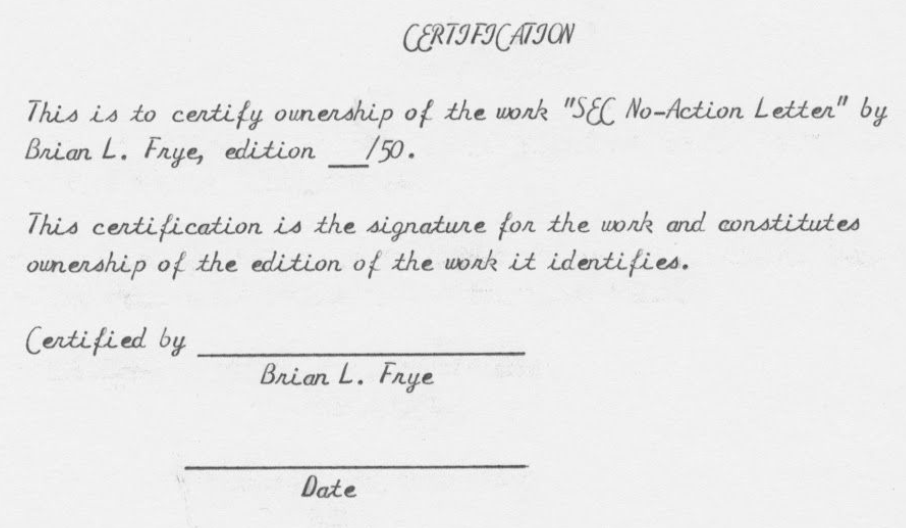Art World
Some People Think Cattelan’s Banana Is Genius. This Law Professor Thinks It’s Illegal
“I was so drunk when I wrote this paper,” admitted Brian Frye, whose legal arguments were quickly squashed by peers.

“I was so drunk when I wrote this paper,” admitted Brian Frye, whose legal arguments were quickly squashed by peers.

by
Brian Boucher

Just when you thought you would never have to swallow another banana, here comes a law professor with a jocular legal argument against Comedian, the artwork that Italian artist Maurizio Cattelan came out of retirement to offer for sale at Art Basel Miami Beach earlier this month.
In a brand-new paper, University of Kentucky Law professor Brian Frye argues not that those three buyers paid too much to Cattelan and his gallery, Perrotin, for a piece of fruit and some duct tape. And he’s not arguing that it isn’t art in the first place. Rather, he’s arguing that it is a financial instrument that defies rules set down by the Securities and Exchange Commission. The $120,000 banana, argues Frye, is a security that Cattelan and his gallery, Perrotin, should never have been allowed to sell in the first place.
But Frye goes even further, proclaiming in the abstract for his paper, dryly titled “SEC No-Action Letter Request,” that “this article is a work of conceptual art in the form of a law review article.” If Cattelan can call a banana an artwork, Frye figures, he can call a certificate of authenticity an artwork. But the twist is that Frye argues that his own letter is an illegal security, and it’s one that he plans to sell: “I propose to sell certificates of ownership of the work ‘SEC No-Action Letter Request’ to the general public in an edition of 50 for $10,000 each,” he says in the paper.
A “no-action letter” is a request typically sent to the SEC by a party who wants to sell something that might fall under SEC regulations. The letter typically asks the SEC to take no action to stop the sale of the product, service, or certificate. But since Frye argues, with tongue in cheek, that since a certificate indicating ownership of an edition of a conceptual artwork is equivalent to a security certificate, “you should deny my request for a no-action letter, because I am proposing to sell an unregistered security.”
In fact, writes Frye, “most conceptual artworks are unregistered securities and the art market is replete with unwitting violations of the securities laws.”

Brian Frye’s certificate of authenticity.
“As I saw artwork increasingly dematerialize, the more I realized that what you’re buying literally fits the definition of a security as adopted by the Supreme Court in the Howey case,” Frye said in a phone conversation. “You’re buying a fractional interest in an abstract business proposition. But it’s even truer to say you’re buying a percentage ownership in the fame. It’s really like conceptual artists securitizing their own celebrity.” In S.E.C. v. W.J. Howey Co., Frye points out, the court observed that “an investment contract for purposes of the Securities Act means a contract, transaction or scheme whereby a person invests his money in a common enterprise and is led to expect profits solely from the efforts of the promoter or a third party.”
Neither Cattelan nor his dealer, Emmanuel Perrotin, wished to comment for this article, probably already being hoarse from speaking to reporters about Cattelan’s stunt, which managed to drown out practically everything else about the fair this year.
But Frye doesn’t expect the artist or gallerist to face regulatory challenges. He’s convinced his letter to the SEC will go into the “crank” folder, he says.
“I was so drunk when I wrote this paper,” said Frye. “It was one o’clock in the morning and I was three sheets to the wind.”
What’s more, Frye is hardly a populist lobbing bombs at the art world; this isn’t even the first artwork he’s created. Frye is a filmmaker who earned an MFA from the San Francisco Art Institute in 1997 before moving to New York and immersing himself in the art world. He earned a spot in the 2002 Whitney Biennial, in the film section, curated by Chrissie Iles, and, subsequently, in the museum’s collection. (The work was also included in the museum’s inaugural exhibition at its new downtown home.) His writings on film have appeared in the uber-cerebral journal October, and he co-produced the award-winning documentary Our Nixon.
Tongue in cheek or not, say three lawyers who have taken a look at Frye’s paper, it’s easy to poke holes in the argument.
Referring to Howey, which Frye cites as precedent, University of Michigan professor Joan Kee wrote to Artnet News in an email that “the Howey test that Brian cites is not just whether something qualifies as an ‘investment contract,’ which includes determining whether the buyers see the transaction as valuable only because of the efforts others perform.” Collectors out here buying works by artists like Felix Gonzalez-Torres, she surmises, are looking less to turn a profit than to own a piece for what the law might call “personal use,” which would exempt it from securities law.

Maurizio Cattelan’s Comedian, for sale from Perrotin at Art Basel Miami Beach. Photo by Sarah Cascone.
In the end, says Kee, “I very much doubt that any court would deem conceptual art as illegal. That said, I like the provocation Brian is putting forward as it has us think more deeply about art’s imbrication with capital via the law.”
If you’re unlikely to turn a profit by buying a conceptual artwork, says New York corporate securities lawyer John Berton, it’s even less likely you’ll hit the jackpot by buying Frye’s certificate. “It’s not clear to me that people who buy his certificates are buying primarily because they’re expecting profit,” Frye told Artnet News via phone. “They’re going along with the gag or they think it’s cool to belong to this little club.”
(Moreover, what had started out as a limited-edition certificate, Frye said, he has decided to produce the certificates in an unlimited edition, undercutting his own offer.)
New York art attorney Amy Goldrich had a similar response to Kee’s, pointing out that collectors buying high-concept artworks are more likely buying for “hedonic purposes,” or, in legal terms, are acting as hobbyists rather than investors.
“Although he gives short shrift to collectors of conceptual art, it’s all good fun,” she said in a phone conversation. “And it just goes to show you, there really is always money in the banana stand.”